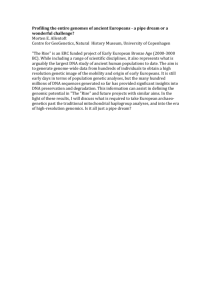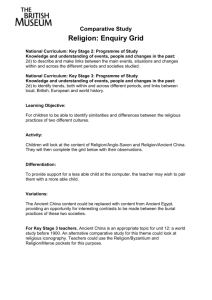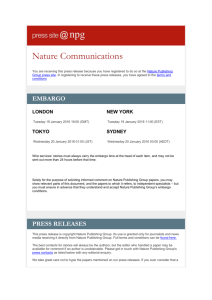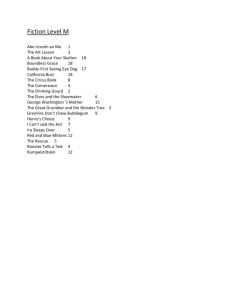Media Release
advertisement
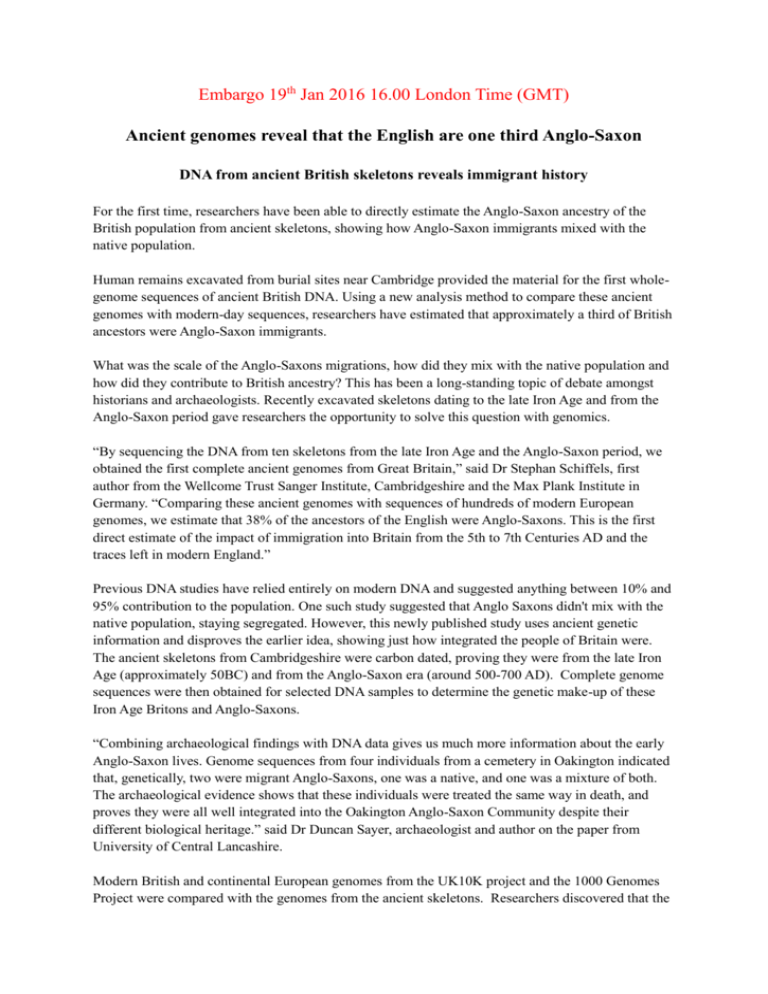
Embargo 19th Jan 2016 16.00 London Time (GMT) Ancient genomes reveal that the English are one third Anglo-Saxon DNA from ancient British skeletons reveals immigrant history For the first time, researchers have been able to directly estimate the Anglo-Saxon ancestry of the British population from ancient skeletons, showing how Anglo-Saxon immigrants mixed with the native population. Human remains excavated from burial sites near Cambridge provided the material for the first wholegenome sequences of ancient British DNA. Using a new analysis method to compare these ancient genomes with modern-day sequences, researchers have estimated that approximately a third of British ancestors were Anglo-Saxon immigrants. What was the scale of the Anglo-Saxons migrations, how did they mix with the native population and how did they contribute to British ancestry? This has been a long-standing topic of debate amongst historians and archaeologists. Recently excavated skeletons dating to the late Iron Age and from the Anglo-Saxon period gave researchers the opportunity to solve this question with genomics. “By sequencing the DNA from ten skeletons from the late Iron Age and the Anglo-Saxon period, we obtained the first complete ancient genomes from Great Britain,” said Dr Stephan Schiffels, first author from the Wellcome Trust Sanger Institute, Cambridgeshire and the Max Plank Institute in Germany. “Comparing these ancient genomes with sequences of hundreds of modern European genomes, we estimate that 38% of the ancestors of the English were Anglo-Saxons. This is the first direct estimate of the impact of immigration into Britain from the 5th to 7th Centuries AD and the traces left in modern England.” Previous DNA studies have relied entirely on modern DNA and suggested anything between 10% and 95% contribution to the population. One such study suggested that Anglo Saxons didn't mix with the native population, staying segregated. However, this newly published study uses ancient genetic information and disproves the earlier idea, showing just how integrated the people of Britain were. The ancient skeletons from Cambridgeshire were carbon dated, proving they were from the late Iron Age (approximately 50BC) and from the Anglo-Saxon era (around 500-700 AD). Complete genome sequences were then obtained for selected DNA samples to determine the genetic make-up of these Iron Age Britons and Anglo-Saxons. “Combining archaeological findings with DNA data gives us much more information about the early Anglo-Saxon lives. Genome sequences from four individuals from a cemetery in Oakington indicated that, genetically, two were migrant Anglo-Saxons, one was a native, and one was a mixture of both. The archaeological evidence shows that these individuals were treated the same way in death, and proves they were all well integrated into the Oakington Anglo-Saxon Community despite their different biological heritage.” said Dr Duncan Sayer, archaeologist and author on the paper from University of Central Lancashire. Modern British and continental European genomes from the UK10K project and the 1000 Genomes Project were compared with the genomes from the ancient skeletons. Researchers discovered that the Anglo-Saxon immigrants were genetically very similar to modern Dutch and Danish, and that they contributed 38% of the DNA of modern people from East England, and 30% for modern Welsh and Scottish. The Anglo-Saxons first settled in the South East of England so this pattern is consistent with their migration pattern. The genomes of northern European populations are similar and it is difficult to accurately distinguish between them. To help solve this problem, the study developed a sensitive new method, called rarecoal, which could identify subtle genetic traces in individuals, using rare genetic variants identified in hundreds of present-day people. Earlier methods of mapping ancient DNA looked at common genetic variants from the very distant past, which are present in most people. The new rarecoal method did exactly the opposite, allowing researchers to map more recent events and unravel very closely related populations. “We wanted to determine where ancient DNA samples would fit with respect to a modern population model and to map individuals into that model. This study, using whole-genome sequencing, allowed us to assign DNA ancestry at extremely high resolution and accurately estimate the Anglo-Saxon mixture fraction for each individual,” said Richard Durbin, senior author at the Sanger Institute. “More full genome sequences and further improvements in methodology will allow us to resolve migrations in even more detail in the future.” Ends Contact details: Dr Samantha Wynne Press Office Wellcome Trust Sanger Institute Cambridge, CB10 1SA Phone: 01223 492368 Email: press.office@sanger.ac.uk Notes to Editors: Publication Iron Age and Anglo-Saxon genomes from East England reveal British migration history. Stephan Schiffels et al. (2016) Nature Communications DOI: 10.1038/ncomm10326 Funding: The Oakington excavations were funded by the Oakington Parish Council, the Institute for Field Research (IFR) and the University of Central Lancashire (UCLan). This work was funded by Australian Research Council grant DP130102158, by the University of Adelaide’s Environment Institute, and by Wellcome Trust Grant 098051. Participating centres: Wellcome Trust Sanger Institute, Hinxton, Cambridge, CB10 1SA, UK Australian Centre for Ancient DNA, School of Biological Sciences, University of Adelaide, SA 5005, Australia. Oxford Archaeology East, 15 Trafalgar Way, Bar Hill, Cambridge, CB23 8SQ, UK Oxford Archaeology South, Janus House, Osney Mead, Oxford, OX2 0ES, UK University of Central Lancashire, Preston, PR1 2HE, UK Max Planck Institute for the Science of Human History, Department for Archaeogenetics, Kahlaische Strasse 10, 07745 Jena, Germany The Genome Analysis Centre, Norwich Research Park, Norwich, NR4 7UH, UK Selected Websites: Australian Centre for Ancient DNA (ACAD) A leading ancient DNA research facility at the University of Adelaide specialising in the analysis of evolutionary processes, human evolution, and the impacts of environmental and climate change through time. Hosts the Online Ancient Genome Repository (OAGR) of ancient human genomes and microbiomes. https://www.adelaide.edu.au/acad/ The University of Adelaide The University of Adelaide is one of Australia’s leading research-intensive universities and is consistently ranked among the top 1% of universities in the world. Established in 1874, it is Australia’s third oldest university with a strong reputation for research and teaching excellence, and producing graduates that make an impact on the world. http://www.adelaide.edu.au/ Oxford Archaeology Oxford Archaeology is one of the largest independent archaeological and heritage practices in Europe, with over 250 specialist staff working out of offices in Oxford, Lancaster and Cambridge. Founded in 1973, we have over 40 years of experience in professional archaeology, and a tradition of quality, innovation and service on projects ranging in scale from domestic extensions to international transport infrastructure. We are also an Institute for Archaeologists Registered Organisation and, as a registered educational charity, we help people to discover and enjoy their heritage through our publications and outreach. Across the country, we have welcomed many thousands of visitors to our sites on open days, regularly provide presentations and information panels, and volunteers of all ages have participated in our wide variety of excavation and survey projects that span all periods of human history. www.oxfordarchaeology.com University of Central Lancashire The University of Central Lancashire (UCLan) in Preston was founded in 1828 as the Institution for the Diffusion of Knowledge. Since those early days it has grown into one of the UK's largest universities with a staff and student community approaching 38,000 and an employment-focused course portfolio containing over 350 undergraduate programmes and nearly 250 postgraduate courses. The University has an established research reputation with world-leading or internationally excellent work taking place within the areas of Business, Health, Humanities and Science. https://www.uclan.ac.uk/ The Wellcome Trust Sanger Institute The Wellcome Trust Sanger Institute is one of the world's leading genome centres. Through its ability to conduct research at scale, it is able to engage in bold and long-term exploratory projects that are designed to influence and empower medical science globally. Institute research findings, generated through its own research programmes and through its leading role in international consortia, are being used to develop new diagnostics and treatments for human disease. http://www.sanger.ac.uk/ The Wellcome Trust The Wellcome Trust is a global charitable foundation dedicated to achieving extraordinary improvements in human and animal health. We support the brightest minds in biomedical research and the medical humanities. Our breadth of support includes public engagement, education and the application of research to improve health. We are independent of both political and commercial interests. http://www.wellcome.ac.uk/

